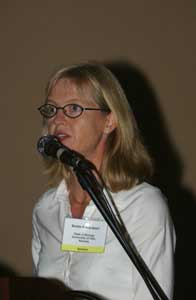Golden Alga (Prymnesium parvum) in Texas
Workshop Abstracts
Phylogeny, Life History, Autecology and Toxicity of Prymnesium parvum
 Bente
Edvardsen1,2* and Aud Larsen3
Bente
Edvardsen1,2* and Aud Larsen3
1University of Oslo, Department of Biology, Section of Marine Biology and Limnology. N-0316 Oslo, Norway; 2Norwegian Institute for Water Research, N-0411 Oslo, Norway; 3University of Bergen, Department of Microbiology, N-5007 Bergen, Norway.
Abstract.--The flagellate Prymnesium parvum has a worldwide distribution in the temperate region of both the Southern and Northern hemispheres. Most records are from low salinity ponds, lakes and river systems, and from coastal and in-shore waters, but it has also been recorded in oceanic localities. Harmful blooms of P. parvum are recurrent in many parts of the world (Asia, Europe, North America, North Africa and Australia) and may result in fish kills causing great economic losses. Prymnesium parvum belongs to the algal division Haptophyta. It is unicellular and has oblong cells with the length 8-16 µm and width 4-10 µm. The cells have two flagella for motility and a third appendage, a haptonema that can be used for attachment to a substrate. The cells have two golden brown chloroplasts containing the photosynthetic apparatus that convert inorganic carbon into organic. Two layers of plate-like, organic scales cover the cells. The scale morphology, which can be seen in the electron microscopy only, is considered to be species-specific. About ten Prymnesium species are presently known. All Prymnesium species sequenced to date group together in the ssu rRNA gene tree, but included in this group are also some species in the genera Chrysochromulina and Platychrysis, indicating that a revision of the taxonomy is needed. Prymnesium nemamethecum and Chrysochromulina polylepis are the closest relatives to P. parvum in this phylogeny. Prymnesium parvum and P. patelliferum were previously considered as two separate species, but DNA sequencing and ploidy analyses revealed that they most probably are stages in the life cycle of one and the same species. Prymnesium parvum thus consists of two forms, P. parvum f. parvum and P. parvum f. patelliferum that differ slightly in scale morphology. Prymnesium parvum is believed to have a sexual haplo-diploid life cycle embracing four morphologically distinct stages: two-flagellated haploid cell types, one- flagellated diploid cell type and a non-motile cyst. The non-flagellated cysts are considered to be a resting stage. Autecology is the relationship between one organism and its environment. P. parvum is extremely euryhaline and eurytherm and may grow at salinities between 1-100 psu. The optimal salinity and temperature for growth as well as maximal growth rate varies among the different strains that have been studied, but in general the highest growth rates have been achieved in the salinity range 10-20 psu and at temperatures 20-26 °C. In addition to perform photosynthesis, P. parvum has the ability to utilize various dissolved organic nutritional resources as well as bacteria and other small prey and is thus mixotrophic. Despite its very euryhaline nature, P. parvum bloom formation has been restricted to waters of low salinities, between 1-12 psu. Usually, the blooms develop at water temperatures above 10 °C, but blooms have also been recorded at a lower temperature. Fish kills have usually occurred only at very high algal concentrations (>50-100 million cells per liter). Considerable amounts of nutrients such as nitrogen and phosphorus are needed to build up Prymnesium populations of this size. Many of the affected waters are also clearly eutrophic due to cultivation of fish, discharge of sewage, or runoff from agricultural land. Prymnesium parvum may bloom in almost any low-salinity, nutrient-rich area in the temperate region of both the Northern and Southern hemispheres. To reduce the risk for harmful Prymnesium blooms it can be recommended to reduce the levels and discharges of dissolved inorganic phosphorus and nitrogen as well as dissolved organic material to these water bodies, and when possible to keep the salinity below 1 psu.
* Presenter at Golden Alga Workshop
Download presentation  (PDF 797.5 KB).
If you are unable to access this document, please contact
us for an alternative format.
(PDF 797.5 KB).
If you are unable to access this document, please contact
us for an alternative format.